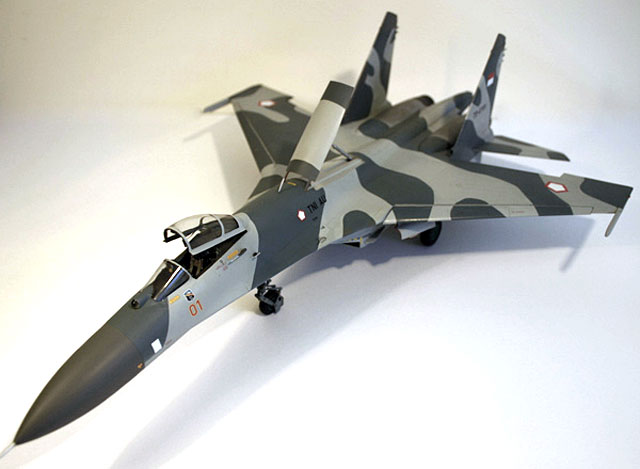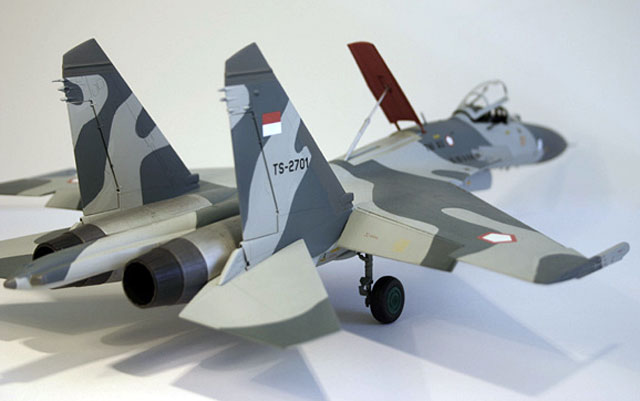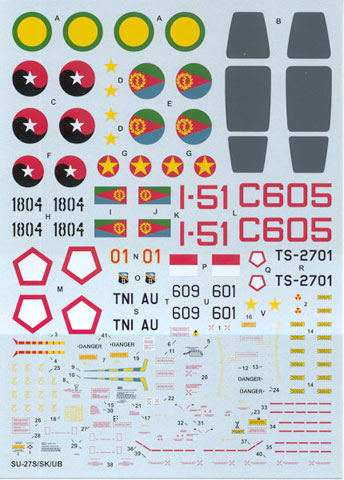|
Su-27S/SK/UB
Flanker B/C

Hi Decal Line, 1/48 scale
|
Summary |
|
Catalogue Number: |
48-022 Su-27S/SK/UB
Flanker B/C |
|
Scale: |
1/48 (also
available in 1/72 scale) |
|
Contents and Media: |
Waterslide decals
plus instructions and notes |
|
Price: |
USD$9.96 available online from Squadron.com |
|
Review Type: |
First Look |
|
Advantages: |
Complete coverage
of six different aircraft from four Air Forces. Perfect register
and minimal carrier film. Detailed colour instructions included.
|
|
Disadvantages: |
Limited
maintenance stencils |
|
Recommendation: |
Highly Recommended |
Reviewed by
Ken
Bowes

Hi Decal Line's Su-27 decals are available online from Squadron
With the collapse
of the Former Soviet Union exports of advanced combat aircraft to many
countries not traditionally seen as client states expanded rapidly.
Nothing demonstrated this more than the order for MiG-29 Fulcrums placed
by Malaysia in 1994. In fact it was this type that dominated initial
exports due to price and lower complexity.

By the mid-1990s,
however, exports of the Su-27 Flanker began to occur in numbers to the
point where the MiG-29 has had little recent success. China was the
first customer outside the Former Soviet Union (FSU) in 1992 and now
operates some 200 of the type with many more on order. Later customers
included Vietnam, India, and Indonesia with 16, 50 and 4 now in service
respectively.
Whilst these
aircraft represent new build and license production, there are also now
many operators of second-hand airframes. Often they are to be found in
small numbers and are known to be piloted by mercenaries trained in FSU
Air Forces. The countries who operate these fleets would surprise some,
given it was only twenty years ago that massive international aid
efforts were underway on their behalf.
It is not easy to
model these small air force Flankers, given the almost complete lack of
documentation. Hi-Decal Line from Poland has however produced a neat
package that slots into this gap in the Flanker user community not
covered by other decal manufacturers.
Hi Decal Line's
1/48 scale sheet provides everything you need to produce an unusual
looking Flanker. The decal sheet is A5 size with enough roundels and
unique markings to make all six subjects (less maintenance stenciling –
more on this later).
 With
six individual airframes from four Air Forces included, there is ample
choice. More noteworthy is the departure in colours from the usual
Flanker grays of the Russian Federation and most mainstream operators.
The subjects covered are: With
six individual airframes from four Air Forces included, there is ample
choice. More noteworthy is the departure in colours from the usual
Flanker grays of the Russian Federation and most mainstream operators.
The subjects covered are:
-
Su-27S Flanker B 1804, 1st
Fighter Squadron, Ethiopian Air Force 1999. This aircraft saw
service in the border wars against Eritrea in 1999 and 2000. The
Flankers proved highly successful with several victories over
Eritrean MiG-29s.
-
Su-27S Flanker B 609, 6th
Fighter Squadron, Eritrean Air Force 2003. In response to the
success of the Ethiopian Flankers, Eritrea sought their own fleet,
refurbished aircraft arriving from the Ukraine in 2003.
-
Su-27UB Flanker C I-51, Angolan Air
Force 2002. Another operator out of left field, Angola has also
supplemented its mercenary flown air force with Flankers, one
already reported to have been shot down by UNITA rebels before the
ceasefire.
-
Su-27UB Flanker C 601, 6th
Fighter Squadron, Eritrean Air Force 2003. Similar to the single
seater above.
-
Su-27S Flanker B C605, Angolan Air
Force 2002. As the Flanker C above with a slight variation in the
camouflage scheme.
-
Su-27SK Flanker B TS-2701, 11 Skn
Indonesian Air Force, Ishwayhudi Air Base 2003. This is one of two
Su-27SKs which were delivered to the TNI-AU along with two Su-30MKs
in August 2003.
The variation in
designations above derives from the airframe source. The Su-27S was the
variant produced for the Soviet Union and in the case of the African
operators have been acquired second-hand from countries such as Belarus
and Ukraine using refurbished FSU stocks. The Su-27SK is the direct
equivalent export model. Visual differences are non-existent, the
variations reflecting modified radar components and computers. All
subjects can be modeled straight from the box with the Academy Flanker B
and C kits in 1/48 scale, although replacing the cockpit interior of
this kit is a must.
As one can imagine,
with the unusual operators there are numerous non-standard
colours
applied. The Ethiopian aircraft are probably the least interesting with
a standard Russian style Flanker scheme applied. The Angolan aircraft
have various greens and olives across their airframes in keeping with
their primary ground attack role and Indonesia adopted a nice two-tone
gray disruptive scheme which varies from the Russian scheme. The
aircraft that have real wow factor are however the Eritrean aircraft.
The pattern owes its origin to the Ukrainian splinter scheme, but the
colours are a mix of pale blues and blue-greens over a pale gray.
Hi-Decal Line has
helpfully provided FS approximations for all schemes, along with
recommendations from the Humbrol and Testor's Model Master lines. I used
the Humbrol matches for my TNI-AU Flanker and believe that the blue-gray
is probably too dark, a touch of white or light gray would probably help
this somewhat.
For recommendations
on such details such as the wheel hubs etc you are left to your own
devices. Fortunately the ubiquitous green of Soviet times seems to have
carried over. More difficult is inside the airbrake. The Indonesian use
of pale blue and red is well documented in photos on their website and
the Ethiopian aircraft are probably primer yellow like Russian airframes
but it is anyone’s guess for the Angolan and Eritrean types. The modeler
is not completely out in the cold for reference on these aircraft. On
the internet Air Combat Group (www.acig.org)
has probably the most comprehensive coverage of the African users,
whilst the
TNI-AU itself has many good images on their official website to help
with the finer points of their airframes.
Having built a
Flanker with this set, a modeler may then not want to use the supplied
maintenance stenciling which is somewhat limited. Linden Hill Decals
addresses this with a comprehensive sheet based on aircraft maintenance
manuals and information from their contacts in Russia. That said
refurbished and export airframes often don’t carry the complete
stenciling found on Russian aircraft. One observer of the TNI-AU
aircraft noted that the stenciling was a combination of Russian and
poorly translated English. One item I noticed with the TNI-AU Flanker is
that the blue and yellow intake flash extends across underneath the
intake, whist Hi-Decal Line only provide that for the sides.
Hi-Decal Line’s
sheet is very well
printed, being very thin and with minimal carrier film. The designs
themselves are printed in perfect register. The decals proved easy to
use and respond well to the usual solutions such as Micro-Sol and
Micro-Set without damage. I had been wary of using these, believing them
to have adherence properties similar to Propagteam Decals, but they were
easy to slide into position once applied to the model. They are quite
thin and they conformed well to the details over which they are laid. I
was very happy with the final appearance on my Academy Su-27SK, with no
silvering occurring despite my usual rough handling.
I believe Hi-Decal
Line have come up with a winner here and I certainly plan to do another
subject off the sheet, most probably an Eritrean Flanker C. In this
sheet they have an excellent product and they should be congratulated
for bringing these very unusual subjects to the market.
Highly Recommended.
Thanks to Hi
Decal Line for the review sample
Click the thumbnails below to view larger images:
Model, Review Text and Images Copyright © 2005 by
Ken Bowes
Page Created 12 January, 2005
Last updated
12 January, 2005
Back to
HyperScale Main Page |
Home | What's
New | Features
| Gallery |
Reviews | Reference
| Forum
| Search